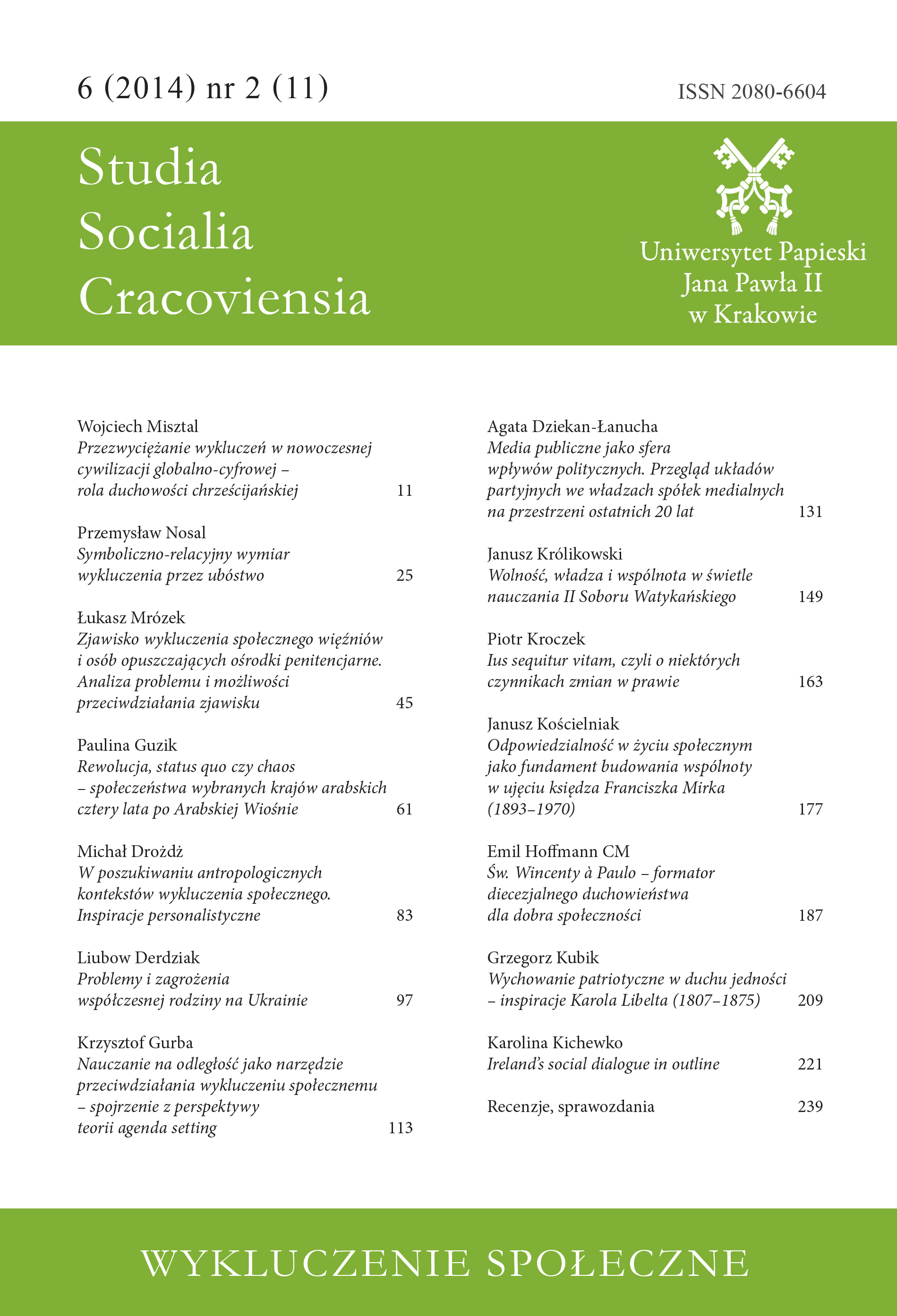Revolutionary, stagnant or chaotic? Societies of selected Arab states four years after the Arab Spring
DOI:
https://doi.org/10.15633/ssc.774Keywords:
Arab Spring, Middle East, democratic revolution, Arab society, “Time”Abstract
The Spring of 2011 in the Arab world and its blooming revolutions were hopeful and precious. The whole world watched as angry masses of young Arabs toppled the regimes, ousting first Tunisia’s Zine El Abedine Ben Ali and then Egypt’s Hosni Mubarak. By the end of the year, with the help of American jetfighters, another bloody dictator was gone – Muamar Kaddafi no longer endangered the people of Libya. Social change was on the way – freedom of speech and freedom to vote were only among other prerogatives of the young civil societies. In 2012 all of those states had new governments and presidents. But something started to go wrong – in democratic elections islamists took over, not only destabilizing the countries, but fermenting newly born civil societies. In 2014, when the old power is back in Egypt, opposition leaders are being killed in Tunisia and Libya indicated sharia law, the world watches how “the class of 2011” – educated young Arabs that started the revolutions of 2011, will handle the changes. The article analyses changes observed within Arab societies in Egypt, Tunisia and Libya from December 2010 till December 2013. Analyses is based on „Time” magazine articles written about the Arab Spring Countries in the above dates.References
Abouzeid R., Postcard: Sidi Bouzid. Visiting the birthplace of the Jasmine Revolution, „Time”, 7.02.2011, s. 8.
Ajami F., The sorrows of Egypt, Foreign Affairs 1995.
Andersen K., The Protester: 2011 Person of the year, „Time”, 26.12.2011, s. 82.
Anderson L., Demystifying the Arab Spring: parsing the differences between Tunisia, Egypt and Libya, Foreign Affairs 2011.
Arab Social Media Report, Facebook usage: Factors and analysys, Dubai School of Government, January 2011, www.unpan1.un.org/intradoc/groups/public/documents/dsg/unpan044212.pdf (30.04.2014).
Arabska Wiosna rok później, „Krakowskie Studia Międzynarodowe” nr 1 (9) 2012.
Arieff A., Political transition in Tunisia, Congressional Research Service, 15.04.2011.
Briefing, The moment, „Time”, 21.02.2011, s. 17.
Cole J., The new Arabs, New York–London–Toronto–New Delhi 2014, loc. 313 (kindle edition).
Danahar P., The new Middle East, New York 2013.
Danecki J., Sulowski S., Bliski Wschód coraz bliżej, Warszawa 2011.
ElBaradei M., Wael Ghonim – spokesman of a revolution, „Time”, 21.04.2011, www.content.time.com/time/specials/packages/article/0,28804,2066367_2066369_2066437,00.html (30.04.2014).
Elliott M., Learn to love the revolution, „Time”, 7.03.2011, s. 30.
Eltantawy N., Wiest J. B., Social media in the Egyptian revolution: reconsidering resource mobilization theory, „International Journal of Communication” www.ijoc.org/index.php/ijoc/article/view/1242/597 (30.06.2014).
Fale Tunisami: kontestacja arabska w latach 2010–2013, red. R. Potocki, M. Piskorski, W. Hładkiewicz, Warszawa 2014.
Gelvin J. L., The Arab uprisings – what everyone needs to know, New York 2012.
Gelvin J. L., The modern Middle East – a history, Oxford–New York 2011.
Ghonim W., Revolution 2.0, Boston–New York 2013.
Ghosh B., Flash point, „Time”, 24.09.2012, s. 33.
Ghosh B., Gaddafi’s last stand, „Time”, 7.03.2011, s. 24.
Ghosh B., Rage rap and revolution, „Time”, 28.02.2011, s. 33.
Ghosh B., Revolution delayed, „Time”, 21.02.2011, s. 35.
Ghosh B., The revolutionaries: how a loose coalition of veteran activists and rookie protesters combined to create the Middle East’s most unusual uprising, „Time”, 14.02.2011, s. 38.
Ghosh B., The Rise of the Salafis, „Time”, 8.10.2012, s. 48.
Hauslohner A., Hope among the ruins, „Time”, 4.06.2012, s. 40.
Hauslohner A., On the Arab street. Rage is contagious, „Time”, 7.02.2011, s. 36.
Indyk M., Back to the bazaar, Foreign Affairs 2002.
International Crisis Group, Tunisia: confronting social and economic challenges,
Jankowski D., Po „arabskiej wiośnie’’ – „zima” dla europejskiej obrony? , „Bezpieczeństwo Narodowe” 2 (2011), nr 18, s. 57.
Jaskiernia A., Media masowe w demokratycznych procesach wyborczych. Standardy europejskie i uwarunkowania ich realizacji, Warszawa 2008.
Klein J., Cairo’s unsettled spring, „Time”, 18.04.2011,
Klein J., Middle East priority: a regional infrastructure bank, „Time”, 17.03.2011, www.content.time.com/time/magazine/article/0,9171,2059609,00.html (30.06.2014).
Lisowska-Magdziarz M., Analiza zawartości mediów. Przewodnik dla studentów, wersja 1.1., „Zeszyty Wydziałowe” Uniwersytet Jagielloński, Kraków, 2004.
Parzymies S., Aspekty wewnętrzne i międzynarodowe „Arabskiej Wiosny”, „Stosunki Międzynarodowe – International Relations” 44 (2011) nr 3–4, s. 35.
Phares W., The lost spring, U.S. policy in the Middle East and catastrophes to avoid, New York 2014.
Stengel R., The Protester - editors note, „Time”, 26.12.2011, s. 53.
Stosunki międzynarodowe na Bliskim Wschodzie po Arabskiej Wiośnie, Krakowskie Studia Międzynarodowe” nr 3 (10) 2013.
The Arab Spring, ed. B. Przybylska-Maszner, Poznań 2011.
The new Arab revolt (praca zbiorowa), New York 2011.
The White House, Office of the Press Secretary, Remarks by the President on Egypt, 11.02.2011, www.whitehouse.gov/the-press-office/2011/02/11/remarks-president-egypt.
Vick K., Street rule, „Time”, 22.07.2013, s. 30.
Walt V., Tunisia’s nervous neighbors watch the Jasmine Revolution, „Time”, 31.01.2011, s. 24.
www.aljazeera.com/indepth/features/2014/01/tunisia-arab-spring-three-years-20141146353728616.html (14.08.2014).
www.content.time.com/time/magazine/article/0,9171,2063873,00.html (30.06.2014).
www.crisisgroup.org/en/multimedia/podcasts/2012/tunisia-lawrence-economic-challenges.aspx (14.08.2014).
www.edition.cnn.com/2013/06/04/world/africa/egypt-ngos/index.html (25.07.2014)
www.edition.cnn.com/2014/06/08/world/africa/egypt-presidential-election (11.08.2014).
www.foreignpolicy.com/articles/2014/08/12/egypts_tiananment_cairo_sisi_rabaa_square_massacre_human_rights_watch?utm_source=Sailthru&utm_medium=email&utm_term=Flashpoints&utm_campaign=2014_FlashPoints%20%28Manual%29 (12.08.2014).
www.hrw.org/sites/default/files/related_material/egypt0814_brochure_web_0.pdf (12.08.2014).
www.huffingtonpost.com/2013/12/18/tunisia-revolution-arab-spring_n_4462064.html (14.08.2014).
Zakaria F., A moment for moderates, „Time“, 1.10.2012, s. 24.
Zakaria F., The revolution, „Time”, 14.02.2011, s. 29.
Zakaria F., Why it’s different this time, „Time”, 28.02.2011, s. 28.
Downloads
Published
Issue
Section
License
Authors who publish with this journal agree to the following terms:
- Authors retain the copyright and full publishing rights without restrictions, and grant the journal right of first publication with the work simultaneously licensed under a Creative Commons Attribution 4.0 International License that allows others to share the work with an acknowledgement of the work's authorship and initial publication in this journal.
- Authors are able to enter into separate, additional contractual arrangements for the non-exclusive distribution of the journal's published version of the work (e.g., post it to an institutional repository or publish it in a book), with an acknowledgement of its initial publication in this journal.
- Authors are permitted and encouraged to post their work online (e.g., in institutional repositories or on their website) prior to and during the submission process, as it can lead to productive exchanges, as well as earlier and greater citation of published work (See The Effect of Open Access).

